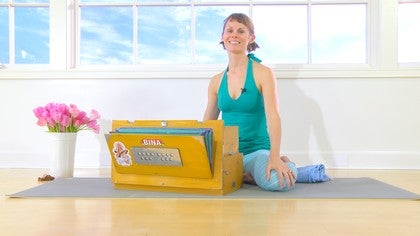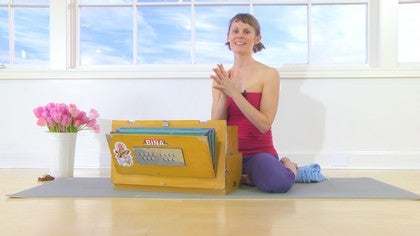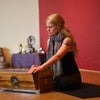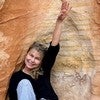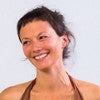Description
About This Video
Transcript
Read Full Transcript
Hi, welcome back, I'm glad you're here. In this practice we'll again go deep into the core and tease out some subtlety there. So we'll begin with the legs in an asymmetrical shape. So we'll extend the left leg straight and we'll bend at the right knee bringing the sole of the right foot pretty close to the left inner thigh. And you might notice how I'm propped up on a blanket and you might like to do that too.
Other ways to modify this shape to support ease in the body from the hips to the collar bones are to add a block underneath the right knee. Stable, soft, easy. Try something and if it doesn't work you can always take it away. So we'll begin super simply here with the left ankle. So we'll plant the left heel into the floor and we'll start to just make some circles underneath the ankle giving ourselves lots of room to have a process of practice here.
Noticing what's required to make this happen. And then starting to notice just how far up the leg, maybe into the core. You feel this. Notice all of the other parts that are moving. Just switch directions.
Oh and that feels different, doesn't it? Notice where things feel sticky. Notice where you feel like butter or olive oil or whatever your preferred fattest. And in time we'll come back to center and we'll organize the body so that your left knee and your left toes are facing the sky. So there's a certain amount of effort required to hold that shape but within that let there be some softness like at the skin.
Things wiggle around a little bit. And from here I'm going to move my block away just so I have a little more room. You might keep it there. Don't always feel like you need to do what I'm doing. Walk the hands forward slowly.
Watch what happens with that knee and see if it wants to flop in and the toes want to flop in. We're going to get really round here and watery and soft so plant the hands on the floor. Let the forehead become heavy. Let the chest become heavy. Let the belly become heavy.
And then the work might be right here across the crease of your left hip. Can you invite softness there? Don't worry if you send this invitation of softness and it feels like she responds with hardness. That's normal. Keep sending the invitation.
And so for the next couple of breaths, let's work with the back and the front halves of the body. So as you breathe in this next time, breathe into the fullness of the back of the body. And as you breathe out again, invite softness into the right hip crease, left hip crease. And as you breathe in, invite length from the pubic bone all the way to the top of the forehead. And as we continue to soften.
And as you breathe in, let's start to walk back up. Notice if anything has happened there with the compass point of your left toes. Invite it back to stability. And with an exhalation, we'll just turn to greet the right knee. Wide hands, hello.
Breathe into the length of the body that's already happening. And as you breathe out, bring the left hand to the top of the right thigh. Some of you might even want to lift that knee up and let the kneecap just sort of hang in the hand like a hammock. Sitting back into the sitting bones. With another breath out, let's look over to the right.
Soften at the shoulders, oh, that's nice. And turn the palm of the right hand to face the sky. And with a breath in, let's start to sweep that right arm up to about 60%. I call this show choir height. And sometimes we sing like Oklahoma, okay.
In this shape. You don't have to, but you could. Start to bend at the right elbow. Bring your hand to the back of the head. Let the head be heavy in the hand.
Soften at the shoulders. And can you invite your neck to take a little bit of a break? She won't want to, but invite it. With a breath in, let's start to pull the torso back up, maybe reach that right hand to the sky. And as you breathe out, start to unwind.
And notice right side of the body, left side of the body. And with a breath out, now we'll turn to greet that left leg, ooh, that's harder. I might need some support there. Notice all of the things that start gripping in order to support that action. And you might run some experiments, what's necessary engagement and what is engagement out of habit.
You'll know it's necessary if you relax somewhere and you sort of fall out of the shape. It's useful information. We'll breathe into the length of the body that's already happening, ease up through the top of the left thigh. And as you breathe out, just feel as though your heart were being called to from across the room. You might keep your head lifted.
The temptation, and I blame the sit and reach from fifth grade, is to just reach for the toes and to really stretch out the back. But if you can lead with your heart, it's a whole different experience. Turn into that left hip pocket and then just at the last minute, let the chin become heavy as the back of the neck lengthens. And can you connect with both lungs, both sides of the torso? As you breathe in, slowly start to come back up.
Coming out with as much sensitivity as we go in, that is serious work. Release your block if you have it and we'll just do a little release here. We'll press the right hand into the floor, shift your weight into that, shift your weight into your right knee, sending the hips forward, maybe reaching for the sky. There's no wrong way to do this. There's nothing to achieve there other than release.
So between sides, let there be a little space just to notice what's happening. And so for some of us, it will make sense to extend the legs straight. For some of us, that's just too much work. And we'll bend and come somewhere soft, just so we can notice. Right side, left side, northern hemisphere, southern hemisphere.
And then we'll set up for side two. So we'll extend the right leg straight, we'll bend the left knee. And right away, you might notice things feel completely different on this side. And that's useful. And so we will set up the pose completely differently on this side.
So again, you might be elevating your sitting bones on a blanket and you might be supporting the outer edge of your left knee with a block. Maybe on this side, you need nothing. And we'll start that just very simple rolling of the ankle, noticing what's required to make it happen, noticing how far up we feel that. Maybe notice what's happening at the hip, how your pelvis is shifting. And then in time, we'll switch directions.
Ooh, things might feel weird and different. Whenever you have that spark where you're like, oh, that feels weird, somewhere inside, say a little hallelujah because you're paying attention, it's awesome. We'll come back to neutral, so the toes and the kneecap are facing the sky. And we'll make our way into this easy, loose, half butterfly. So it's a real yinny place to be, very watery.
We'll walk the hands forward a bit. And as you do that, invite the right hip, the top of the right hip to soften, to settle, pressing the hands into the floor, let things become heavy and soft, and then breathe into the fullness of the back of the body, the breadth of the shoulders. And as you breathe out, soften, soften into that hip. Breathe into the length from the pubic bone to the forehead, and soften. And as you breathe in, start to slowly walk the torso back toward upright.
Notice if anything has changed over here in the straight leg. And with a breath out, we'll just turn to greet this left knee, the bent leg knee. Wide hands, wide arms, a smile across the collarbones, maybe the face. Notice what's happening over here. Are you gripping?
Can you soften? And you might bring the right hand to the top of the left thigh, or even lift up the knee and hold that knee like a hammock. And that'll invite you to sit back a little bit, invite the heart to bloom, and a smile to happen across the collarbones. Maybe looking over the left shoulder, turn the palm of the left hand to face the sky. And as you breathe in, start to bring it up to about 60%, soften, maybe sing something.
Bending at the elbows, bring the hand to the back of the skull, and let the weight of the head rest in the hands, soft in the shoulders. And as you breathe in, start to come back up, and we'll breathe out and release. And on a breath out, we'll turn to face the right leg, and as you do that, you might notice that you need to reconfigure your props, support something. Breathing into the length of the body, and breathing out, feeling like your heart is being invited, like, remember in the great Gatsby how Daisy was like always whispering so you would come closer? Imagine like someone were whispering to your heart, come closer, come closer.
It's also a literature class. At the last minute, let the chin tuck, soften into that right hip, and as you breathe in, start to come all the way back up. We'll press the left hand into the floor, just next to the hip, shift the weight forward into the left knee, press the right foot into the floor. Breathe like you, moving away that feels good here. And then just notice.
So we'll practice boat pose, Navasana, and I'd like us to make a deal. I am a mom to an almost four-year-old who's always cutting deals with me, so maybe that's why this is something that I do. But you're at home or somewhere where it's just you, and you don't have anything to prove to anyone with respect to this pose. So can we just go there together and not worry about it looking a certain way? Okay, so we'll bring the knees together.
We'll come to sit with the feet in front of the body. And if you come here and you're already feeling like some pressure in your tailbone that makes things grippy, pad the floor with your blanket right under your butt, your booty, your keister, whatever you want to call it. And then we'll bring the hands to the tops of the thighs, and we'll just start to sit back a little bit, like just scooch things a little bit closer. We're just sitting here, like nothing to prove, nothing to see here. And so what we'll do is we'll just notice where our backside is making contact with the floor.
Let it make contact. Invite the belly button just like a scooch closer to the spine, a mini-scooch. And invite the heart to bloom. So a lot of effort might be happening. And we let there be a little ease too.
Start to shift your weight, and you're just coming like to the tippy toes here. Nothing to see, nothing fancy happening here. Notice what's making contact with earth. Invite the belly to move a millimeter closer to the spine, and invite the heart to bloom. And then softness.
Maybe your feet come up off the floor. It doesn't matter if they do, like you're doing it whether they're on the floor or not. And when it's time, like there's just trust. There's no other action required. Belly toward the spine, heart blooms.
Maybe the feet lift up. If you start to grip or hunch, come back a notch. Now, the real work here is then noticing what's happening at the crease of the hips. Can we let just the teeniest bit of softness sort of ooze into there? Maybe the shins come a little bit higher.
But if you start gripping, like, ooh, I started gripping somewhere, I'm going to ease up a little bit and let it go. Hug your knees. So like when you do the work without it needing to be anything, like that's the yoga. That is the yoga. Real work.
Should we do it again? Yeah. Let's hug the knees, make contact with the floor, move the belly, and just the teeniest, teeniest bit closer to the spine, invite the heart to bloom, soften, shift the weight, letting it just be easy in the jaw, soft from earlobe to tops of the shoulders, easy through the crease of the hips. And let it go. Hug those knees, lengthen the spine.
Come down onto the floor, onto our bellies, all the way down. And so this next shape might look a whole heck of a lot like Dhanurasana, but it's not. So if you're tempted to go into a backbend, you're normal because you might have done that in the past, but ease up. The idea is ease here across the crease of the hips. So lower down, untuck the toes, and we'll start just breathing in, pressing the pelvis into the floor and breathing out, relaxing the effort.
And we'll do that, you know, maybe five times. And then the work is in doing it with 5% less effort each time. And so from here, bend at the knees, moving the heels in general closer to your backside. See, I told you it would look like Dhanurasana. So this is option number one.
Option number two is to reach the hands back. And if your feet are within easy reach, just to hold onto them and let the shoulders become heavy. No effort. If there's effort or you feel like you're already pulling yourself into a backbend, then let go. Everything else is the same.
Remember, our deal still stands, nothing to prove here. As you breathe in, press the pelvis into the floor. And as you breathe out, release. And we'll do that a couple of times, just like that, press the pelvis into the floor and release. And now we'll start to do it with 5% less effort each time.
Notice if you're hardening anywhere. And the next time that you're breathing in and engaging, we'll stay there just for a breath, just noticing what's happening, noticing what you feel. And then letting go, relaxing all of the effort, maybe windshield wipering the feet and lower legs from side to side. We'll release the legs back to the floor, bring the hands under the shoulders and lift the torso up just enough so that you can plant your left hand on the floor. Take the right hand and arm and slide it, palm facing up, underneath the left arm.
Come to rest on the right shoulder. And then start to walk your left hand toward the top of the mat. We'll bring the right side of your head, so like your brow bone, to meet the floor. Then let your left elbow soften, the left shoulder soften. Now from here, you have a couple of choices.
You can keep your legs as they are, or you can externally rotate the left hip and slide that knee out to like a half frog shape. Or you could bring the sole of that left foot closer to the inner right thigh for a reclining tree, reclining belly down rishasana. Softness in the left shoulder is the work. Just slide that left hand back just so that it's next to your face. Press that hand into the floor, unwind, and we'll extend the right arm back behind you.
Press that left hand into the floor as you start to roll onto the right side of your body. This could be your pose. For some of you, it will make sense to take that top leg, the left leg, and step it back. If you start to silently repeat the F word, ease up a little or a lot. Notice the places where you might be holding out of habit and invite softness there.
And with a breath out, we'll start to roll back onto the belly. Maybe shimmy the shoulders. Notice what you feel. So for side two, we'll lift up a little bit, just enough so that we can scooch that right hand forward and slide the left hand under the body, palm facing up. Come down to rest on the left shoulder as you start to shimmy or scooch your right hand toward the top of the mat, and then soften at the elbow, soften at the shoulder.
Bring the left brow bone or left temple to the floor. And again, you might keep the legs where they are, or you might take a belly down tree pose with the right leg or a half frog externally rotating at the hip, softening through the pelvis, the low belly. We'll slide the right hand back so that just next to the face, press that palm into the floor, lifting up, extending the left arm out, coming down to rest on the left temple. Press the right hand into the floor and then roll onto the left side. And for some of us, it might be fun and interesting to bend and step back.
Just what you feel. And as you breathe in, roll back onto the belly, maybe shimmy the shoulders. And we'll bring the hands right below the tops of the shoulders, so right below the heads of the arms, and we'll tuck the toes under. Press the balls of the feet actively into the floor so that your kneecaps lift. Now from here, can you sort of shift the gaze of your sitting bones down toward the feet?
That's subtle. Like probably unless someone were staring right at your tush, they would, no one would see that, weirdos. Draw the belly toward the spine and invite the heart to bloom. Notice my forehead is still on the floor, my chest is still on the floor, but so much has happened. Press the palms of the hands into the floor here, squeeze the elbows in toward the body.
So much is happening. Now let's try something. We'll press the hands into the floor, and we'll start to lift the forehead away from the floor. Bring the hands into the floor, and start to press up toward plank. Lower the knees to the floor, and move either to table, or to downward facing dog.
And you will need your blocks soon, so this is a good time to grab them. One will be sort of near the belly, one will be toward the top of the mat. Breathe into the back of the body, soften. As you inhale, bend the knees, step the right foot forward, and it'll take a little organizing here with the props. So give it some time.
We'll lower the left knee down to the floor, and we're going to cozy this block right up just below the point of your left hip. Let yourself settle into it. Yeah. Top block is just next to your right foot, and we'll start by breathing into the fullness of the back of the body, breathing from the pubic bone to the hairline. And as you breathe out, start to soften the heart toward the earth.
Notice what you feel, notice where you feel. So something interesting to do while you're in this particular shape is to bring your awareness to your right sitting bone. Can you sort of travel there mentally? And notice the distance from your right sitting bone to the back of the right knee. Trace a path there.
We'll bring the hands back to the block. We'll move this little block out of the way, shift the hips back, and we'll slowly ease our way either to table or to downward facing dog. On a breath in, bend the knees, step the left foot forward. Lower the right knee to the floor, and then we'll cozy that block right up just below the point of the right hip. You might bring your hands, both of them, to the block on the inside edge of the left leg.
Breathe into the fullness of your body, and as you breathe out, soften the heart toward the earth. Can you lean into that right hip a little bit? Can you locate from the inside a sense of where your left sitting bone is, and trace the path to the back of the left knee? Sometimes it's useful to reach back there. Okay, there it is.
Can I feel that from the inside? Bring the hands to the block. We can move the blocks out of the way, and we'll ease our way back to table or downward facing dog. And in time, we'll come all the way down, and we'll come to rest on our right side, and you might extend the right arm up overhead, come to rest, bending the knees. Something that might be interesting to you is to place your left hand in your right armpit.
Allow the eyes to close, and start to shift your attention to the left nostril, noticing the sensation of breath passing through that place. And if you're holding your armpit, release that hand, and sort of brace yourself with the left hand so that you can roll over onto the left side, bending the knees, extending the left arm up overhead. Again, maybe you take that right hand and just sort of bring it into the armpit. And once you've sort of settled, you know, once the dust has settled, let your awareness shift into your right nostril, and what's happening there already. And we'll start to prepare for a shape.
Of rest. So if there are movements that still need to be made, then make them. And the shape that you take is whatever shape is restful to you. So it could be on the belly, or on your side, on your back. Let everything settle into the bones.
And let the bones settle into the earth. And stay here as long as you like, but when it's time to move, start slowly. And move just like you. Ultimately, finding your way back to your seat. Thank you for sharing this space.
Peace.
Practical Magic
Comments
You need to be a subscriber to post a comment.
Please Log In or Create an Account to start your free trial.

